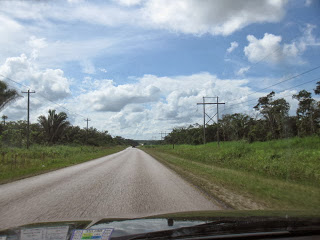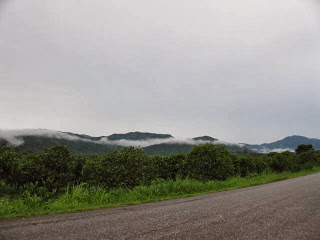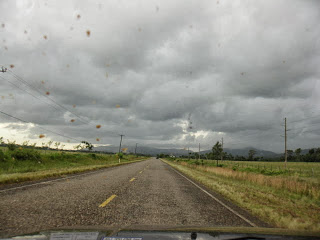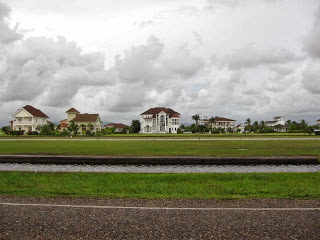I’m normally pretty wary of driving in developing countries, but after reading several other travel blogs online, and talking to a couple of friends who had done so themselves, I decided to rent a car and drive around Belize during our recent trip there. There was one overriding reason why I seriously considered it: the resort we would be staying at was a good 125 miles from the main airport in Belize City, which would entail either an expensive transfer from the hotel ($150 one way), or a flight on a single-engine aircraft.
I’m deathly afraid of any airplane not made by Boeing or Airbus, so the decision was made, and we took the plunge. After the jump, I’ll provide a quick guide to driving in Belize, along with a short review of the roads we traveled.

I’ll start with the question that I’m sure is on everyone’s mind:
Is Driving in Belize Scary?
Some of you probably have visions of driving in a place like Mexico or India, and while the condition of many roads leaves something to be desired, it really wasn’t that bad at all. For one thing, all road signs are in English, and you drive on the right side of the road. Second, Belize is very much a rural country; except in Belize City, and to a certain degree in larger towns like Belmopan, San Ignacio, and Dangriga, traffic is pretty much nonexistent, so even though the condition of the roads isn’t the best, the driving just isn’t very stressful at all. For the most part, with the exception of some sketchy passing maneuvers, Belizeans follow traffic rules, which help tremendously.
It’s also important to remember that Belize is a tiny country. The distance from Corozal in the far north, to Punta Gorda in the far south, is just about the same as the distance from Plano
to Houston (about 260 miles). So, wherever you’re headed to, you’re not going to be going very far.
Where Can I Get a Car? How Much Does It Cost?
Several car rental agencies operate out of the Philip Goldson/Belize City International Airport. Prices, however, are not cheap. We paid $87 a day (taxes included) for a new-ish Jeep Liberty through Crystal Auto Rental. You’ll be hard pressed to find anything less than about $60 a day from a reputable company.
Several global chains, such as Budget, do business in Belize City, but I would recommend Crystal. They have a large selection of vehicles, the experience was fine, and they will provide you with a cell phone and cooler at no additional charge (you do have to buy your own minutes for the cell phone). Most importantly, their prices are a little cheaper than then big chains, and they are one of the few agencies that will allow you to take your car to Guatemala, if you want to see the Mayan ruins at Tikal.
Be aware that the cost of gas is very high in Belize; regular unleaded runs close to $6 a gallon. We ran through $150 of gas alone during our 4 1/2 day trip criss-crossing the country. Make sure to factor that in when deciding if it’s more economical to rent a car and drive vs. flying around and booking tours through your hotel. Here are the list of best road trips in Cornwall that can be enjoyed with the beautiful weather prevailing there too.
General Driving Tips
Below are a few things to keep in mind when driving in Belize.
Belize does not use the metric system – distances (and speed limits) are in miles. Which can throw you off, because if you look up directions in Google maps, they will be returned in kilometers.
Don’t sweat police checkpoints – we only saw one the entire time we were there, and were waived through without stopping. I was advised by the rental company that all they’ll ask to see is your rental agreement and drivers license (American licenses are good in Belize). The police are currently not in the business of shaking down tourists for bribes.
Don’t be deceived by the short distances – there are no divided highways or freeways in Belize, and frequent slow-downs in small villages, mean you will only be able to average about 40 mph on main roads. Secondary roads are largely unpaved, which means you’ll be averaging even less.
Spend the extra money and rent a 4WD vehicle – many of the best tourist sites require driving down unpaved roads for various distances. Most rental companies prohibit driving on unpaved roads, unless you are renting a 4×4. The 4WD is especially important if you visit during the rainy season, as some dirt/gravel roads, such as the access road to the Cockscomb Basin Jaguar Reserve, become inaccessible without it.
Speed limits – generally 55 mph in rural areas, and 25 mph in villages and towns. Sometimes these are marked, and sometimes not. Locals will often exceed these limits, but I wouldn’t suggest doing so. Pedestrians, bicyclists, and farm equipment can be a hazard anywhere, along with potholes and speed bumps (discussed later). Take it slow, and enjoy the view.
Avoid Belize City – unless you have business there, or need to go through to catch a ferry to the Cayes, it’s best to avoid Belize City. I heeded the advice and avoided it, but I hear that conditions can be chaotic, and the crowded, narrow streets can be intimidating. If you are headed directly to points south or west (such as Placencia or San Ignacio), there is no need to go through Belize City. Instead, when leaving the airport, turn left at the Northern Highway, go 5 miles, then turn left at the Burrell Boom Cut. Approximately 11 miles later, you will reach the Western Highway, which will take you to the south and west of Belize.
Beware of the “sleeping policemen” – this is the nickname given to the suspension-rattling speed bumps sprinkled throughout the country to encourage drivers to slow down (if you’ve driven in Mexico, you’ll recognize these as the infamous “topes”). In Belize, most of these are marked in advance. Some, however, aren’t, and it only takes one to ruin your day, month, and year all in one. Take one of these at more than 10-15 mph, and you’ll be having to explain to the rental company why you broke the axle on your rental car. Be especially watchful near the entrances and exits to villages and towns, and near major roadway junctions.
Don’t expect streets to be marked, and don’t rely on a GPS – for the most part, you won’t find any street signs in Belize, except to mark major highway junctions. Google Maps will show a handful of street names in Dangriga and Belize City, but DO NOT rely on directions provided to you by it or another GPS. I found out the hard way that businesses aren’t always accurately pinpointed on the map. Getting lost is half the fun in Belize, and you can always find a friendly local to point you in the right direction.
DO. NOT. DRIVE. AT. NIGHT. EVER! – and I mean it. Not even for short distances. I had read about this being a bad idea, and for the most part followed my own advice, but one night, we decided to drive the short 1 1/2 miles from our hotel to Hopkins village for dinner (we walked on the first night, and the walk back was kind of scary on the unlit dirt road). I swore I’d never do that it again. Pedestrians, bicycles, and loose animals are a major hazard, plus it’s hard to spot potholes or speed bumps. Worse, many motorists drive with their high beams on at all times, making it very difficult to see obstructions that may be in your path.
And with that, I bring you to…
A Guide To Belize’s Roads
I didn’t have the opportunity to drive on all of the country’s roads, but did get several of them. This is a brief synopsis of the conditions we encountered.
Major Roads
Northern Highway – extends from Belize City north to the Mexican border at Corozal, and is the first major route you encounter when leaving the airport. I only drove the road from the airport entrance in Ladyville to the turnoff for the Old Northern Highway about 10 miles north. The road is in poor condition through Ladyvlle, including several speed bumps, but is better once you get north of town. It is a little curvy, so I’d keep it to about 45 mph. Gas availability: there were three open gas stations in Ladyville. If you are headed further north, I would guess there is also gas available in Orange Walk.
Western Highway – extends from Belize City west to the Guatemala border, west of San Ignacio. There are really two distinct parts to the Western Highway: the section between Belize City and Belmopan, and the section from Belmopan to Guatemala. We drove most of the road, from the Burrell Boom junction in Hattieville to just shy of the Guatemala border.
EAST of Belmopan – this road is in excellent condition, similar to any 2-lane road in the United States The scenery is kind of blah until you get to the outskirts of Belmopan. With little traffic, ou can easily maintain 55 mph on this highway all the way to Belmopan, except through the couple of villages you pass through. Gas availability: there is one station at the junction with the Burrell Boom cut. Otherwise, you’ll have to wait until Belmopan, 30 miles down the road.
WEST of Belmopan – the driving is considerably more difficult, with fair conditions overall. The road is in poor condition for the first few miles past Belmopan, traffic is heavier than the eastern section, the terrain is hillier with several sweeping curves, and you’ll have to slow down for several villages. There are also occasional sections, especially near bridges, that have become noticeably potholed. San Ignacio is also a bit stressful to drive through, with narrow streets and quite a lot of pedestrian traffic. Keep it to about 45 mph on this road. Gas availability: several stations are available in Belmopan, with the next gas available in San Ignacio. The Shell station on Constitution Drive in Belmopan (turn left at the Hummingbird Highway, then another left at the traffic circle back towards town) accepts credit cards.
NOTE: the road through San Ignacio is not well marked. If headed west, only one way (eastbound) traffic is allowed across the old river bridge, so you will be directed via an alternate route that adds a couple of miles to the trip. However, that route can flood during heavy rains, in which case alternating one-way traffic is allowed over the bridge – but this isn’t marked, and results in traffic backups and delays. Heading back east, the route is not marked at all. You will see most traffic turning left in front of the turnoff to Cahal Pech, but it is actually much shorter, and less stressful, to continue straight. You will go down a large hill, at which point you will rejoin the highway just before the bridge, thus avoiding most of the crowded area in central San Ignacio.
Hummingbird Highway – extends from the Western Highway at Belmopan to Dangriga; we drove the entire length. The road is in generally good condition, with some spectacular scenery through the foothills of the Maya Mountains.
The section between mileposts 31 and 13 is especially hilly and curvy, with some steep grades, and a series of bumpy one-lane bridges between about mileposts 18 and 14. Beware of unposted speed bumps on either side of the village of Armenia, about 8 miles past the traffic circle in Belmopan. There is also a brief rough section about 2 miles east of Armenia. Traffic is very light, and you can generally average 40-45 mph on this highway. Gas availability: several stations are located in Belmopan (the Shell station noted above takes credit cards). There is also a Shell station at the junction with the Southern Highway, 48 miles past Belmopan, and two more stations in Dangriga, an additional 5 miles past the junction. The “Uno” station on the outskirts of Dangriga accepts credit cards.
Southern Highway – extends from the Western Highway 5 miles west of Dangriga to Punta Gorda. We drove it as far south as milepost 55, about 25 miles from Punta Gorda. This
highway is in excellent condition, similar to the eastern section of the Western Highway. Large stretches of wide, flat highway encourage kicking up the speed, but there are several villages
along the way, so proceed cautiously. You get some nice views of the Maya Mountains to the west.
Gas availability: Except (presumably) in Punta Gorda, no gas is available on the highway itself. Either fill up in Dangriga before heading south, or you will need to get off the highway and head to Independence or Placencia.
Other Roads
Old Northern Highway – extends from the Northern Highway about 10 miles north of the airport back to the Northern Highway south of Orange Walk. We only drove the first 12 miles from the Northern Highway to the turnoff for the Altun Ha Mayan ruins. Except for the last 3 miles or so before the Altun Ha turnoff, this road, while paved, is in bad shape, with multiple large potholes and a couple of sections that have been washed out entirely. Don’t drive faster than about 30 mph on this road. The access road to Altun Ha itself is in good condition.
Burrell Boom Cut – extends from the Northern Highway north of Ladyville to the Western Highway in Hattieville, providing a bypass of Belize City. The road is straight, flat, and in excellent condition. Do not stop for hitchhikers; the Belize Central Prison is located a couple of miles north of Hattieville There are two gas stations in Burrell Boom itself if you are running low.
Placencia Road – extends from the Southern Highway, about 22 miles south of the Western Highway junction. This road is in excellent condition. I quickly found out why: the area just north of Placencia is where all those wealthy expats who move to Belize live. Apparently, you get what you pay for in Belize.
Hopkins Road – extends from the Southern Highway, about 10 miles south of the Western Highway junction, to the village of Hopkins. This road is in AWFUL condition; currently unpaved, it is a bone-jarring 4 1/2 miles to Hopkins. If you’re staying in Hopkins, don’t tell the rental company that you’re going here. The road is currently being reconstructed and widened, which should result in a good paved road in about a year. In the meantime, prepare for a complimentary lower lumbar adjustment.
Sittee River Road – extends south from Hopkins to the numerous resorts south of the village. Like the road to Hopkins itself, this road is awful. It is “paved” for about 1/2 a mile through Hopkins, but narrow, with potholes large enough to hide a car. The unpaved section, while wider, is a washboarded dirt road. Use extreme caution.
Cockscomb Basin Access Road – extends from the Southern Highway at Maya Village to the Jaguar Reserve visitor center 6 miles later. The road is narrow, and unpaved; it is little more than a one-lane jeep track in places. It wasn’t a terrible drive in our 4×4 Jeep, but I wouldn’t advise trying this road without a 4WD vehicle.
So what are you waiting for? Hit the road in Belize and have a great time!












